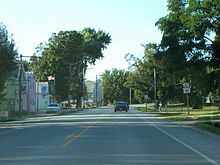Brothertown, Wisconsin
| Brothertown, Wisconsin | |
|---|---|
| Town | |
 | |
| Coordinates: 43°58′28″N 88°15′4″W / 43.97444°N 88.25111°W | |
| Country | United States |
| State | Wisconsin |
| County | Calumet |
| Area | |
| • Total | 54.5 sq mi (141.0 km2) |
| • Land | 36.8 sq mi (95.3 km2) |
| • Water | 17.7 sq mi (45.8 km2) |
| Elevation[1] | 984 ft (300 m) |
| Population (2000) | |
| • Total | 1,404 |
| • Density | 38.2/sq mi (14.7/km2) |
| Time zone | Central (CST) (UTC-6) |
| • Summer (DST) | CDT (UTC-5) |
| Area code(s) | 920 |
| FIPS code | 55-10350[2] |
| GNIS feature ID | 1582873[1] |


Brothertown is a town in Calumet County in the U.S. state of Wisconsin. The population was 1,404 at the 2000 census. The unincorporated communities of Brothertown, Charlesburg, Eckers Lakeland, Jericho, Maple Heights, and Quinney are located in the town. The unincorporated community of Calumetville is also located partially in the town.
History
The town was inhabited by the Brothertown Indians, who moved here from the state of New York from 1831 to 1836. The town was created on March 21, 1843 as Manchester.[3] It was renamed as Brothertown on May 4/May 5, 1857.[3]
Current
The official newspaper of the town is the Chilton Times-Journal.[4] Notices are published at the town hall on St. Charles Road, Pete's Fisherman's Inn in Brothertown and outside the former Roman Catholic Church in Charlesburg.[4] As of 2008, the town chairman is Jeanold Puetz.[4] The town lies in the New Holstein/Moraine Park Technical College and Chilton/Fox Valley Technical College school districts.[4]
Geography
According to the United States Census Bureau, the town has a total area of 54.5 square miles (141.0 km²), of which, 36.8 square miles (95.3 km²) of it is land and 17.7 square miles (45.8 km²) of it (32.45%) is water.
Demographics
As of the census[2] of 2000, there were 1,404 people, 523 households, and 380 families residing in the town. The population density was 38.2 people per square mile (14.7/km²). There were 627 housing units at an average density of 17.0 per square mile (6.6/km²). The racial makeup of the town was 99.79% White, 0.07% African American, 0.07% Native American, and 0.07% from two or more races. Hispanic or Latino of any race were 0.36% of the population.
There were 523 households out of which 33.3% had children under the age of 18 living with them, 63.3% were married couples living together, 4.2% had a female householder with no husband present, and 27.2% were non-families. 23.1% of all households were made up of individuals and 8.0% had someone living alone who was 65 years of age or older. The average household size was 2.68 and the average family size was 3.19.
In the town the population was spread out with 27.3% under the age of 18, 7.7% from 18 to 24, 29.8% from 25 to 44, 23.7% from 45 to 64, and 11.5% who were 65 years of age or older. The median age was 37 years. For every 100 females there were 109.6 males. For every 100 females age 18 and over, there were 119.1 males.
The median income for a household in the town was $49,861, and the median income for a family was $58,083. Males had a median income of $36,929 versus $25,625 for females. The per capita income for the town was $19,816. About 1.0% of families and 1.6% of the population were below the poverty line, including 1.3% of those under age 18 and 3.9% of those age 65 or over.
Coordinates: 43°58′05″N 88°18′32″W / 43.96806°N 88.30889°W
References
- ↑ 1.0 1.1 "US Board on Geographic Names". United States Geological Survey. 2007-10-25. Retrieved 2008-01-31.
- ↑ 2.0 2.1 "American FactFinder". United States Census Bureau. Retrieved 2008-01-31.
- ↑ 3.0 3.1 Town of Manchester; Wisconsin Historical Society; Accessed July 24, 2008
- ↑ 4.0 4.1 4.2 4.3 Town of Brothertown - 2008 Newsletter
| |||||||||||||||||||||||||||||
